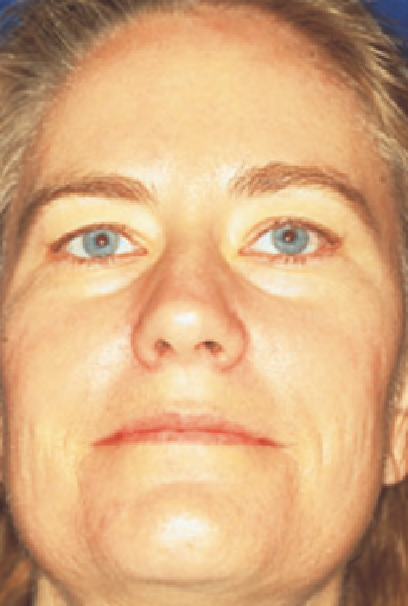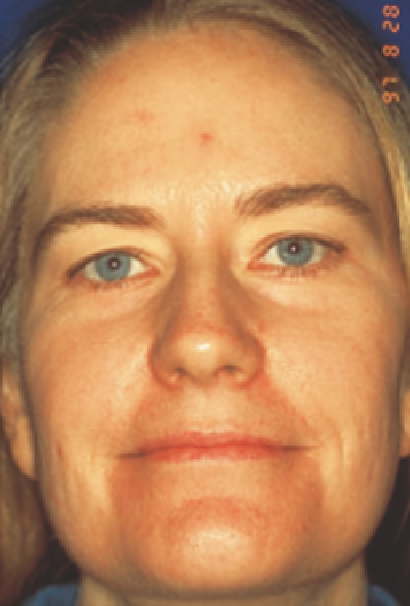Biomedical Engineering Reference
In-Depth Information
(
A
)
(
B
)
Figure 6.47
When treating early photodamage (
A
) especially if the patient desires to return to work with as little healing time as possible, epidermis is removed
with CO
2
laser and superfi cial dermal resurfacing performed with erbium laser. (
B
) Although moderate improvement is seen, tissue tightening of cheeks and
removal of deeper lines are not accomplished.
6. The Er:YAG laser is used with a small, focused spot
size to sculpt tissue previously treated with the
3-mm CO
2
spot to smooth the tissue as uniformly
as possible by ablating the necrotic tissue.
7. The periphery is feathered with the Er:YAG laser us-
ing a defocused energy of 1.0-1.7 J and a 5- to 8-mm
diameter spot. This treatment protocol maximizes the
benefi t that can be achieved with each laser (Fig. 6.41).
indications, potential side effects, and recommendations for
treatment are not possible until larger studies are completed
(58-62,298). Ross et al. found statistically signifi cant improve-
ments in pigmentation, wrinkles, and skin tone following two
treatments spaced 1 month apart in a small case series of eight
patients (58). There were no noted cases of postinfl ammatory
hyperpigmentation, infections, or scarring. Then, longer-term
effi cacy was demonstrated by Zelickson and colleagues (298),
who evaluated 11 subjects with the Er:YSGG laser using a fl u-
ence of 3.5 J/cm
2
, pulse duration of 0.4 ms, and 20% overlap.
Two treatments were performed 6 weeks apart. Ninety-one
percent of subjects showed improvement in tone/texture, 82%
of subjects showed improvement in dyschromia and fi ne lines,
and 54% showed improvement in wrinkles 6 weeks after the
fi nal treatment. At the 2-year follow-up visit, 57% of the overall
improvement achieved at 6 weeks was maintained. No adverse
events were reported throughout the study. The role of Er:YSGG
resurfacing appears to be promising, although more data are
needed before its role in facial rejuvenation gains clarity.
the e
:ysgg laser
Er:YSGG Laser-Tissue Interactions
The Er:YSGG that emits laser energy at a wavelength of 2790 nm
and has a water absorption coeffi cient of 5000/cm
2
, roughly
midway between Er:YAG (12,500/cm
2
) and CO
2
(1000/cm
2
)
(58). This corresponds to an ablative threshold of about 3 J/cm
2
when deployed with a pulse duration between 200 and 800
r
s.
Interest in the Er:YSGG laser, much like the “modulated”
Er:YAG, stems from its potential to impart a balance of depth
and thermal impact not easily achievable with either of the other
ablative wavelengths. Additionally, Ross and colleagues (58) sug-
gested that tissue ablation can occur without removal of the
ablative tissue, thereby allowing it to serve as a “biological dress-
ing,” thereby increasing the rate of healing following the proce-
dure. The recovery time for Er:YSGG laser resurfacing based on
limited current literature is about 3-5 days and is considerably
shorter than traditional CO
2
resurfacing. The Er:YSGG 2790-nm
laser is produced by Cutera (Brisbane, California, USA).
Currently, there are limited published data on ablative resur-
facing with the Er:YSGG laser and hence a full discussion of
μ
future trends
A wealth of clinical literature has established the ablative
resurfacing lasers as reliable, effective, and versatile tools for
cutaneous rejuvenation. Patient satisfaction from cutaneous
laser resurfacing remains high. A prospective survey of patients
who underwent full-face resurfacing 30 months before
reported that 88% of these patients felt that their appearance
had improved, 75% would recommend the procedure, and
71% of them would undergo laser skin resurfacing again (57).


















